|
|
 |
|
Calanoida ( Order ) |
|
|
|
Clausocalanoidea ( Superfamily ) |
|
|
|
Euchaetidae ( Family ) |
|
|
|
Paraeuchaeta ( Genus ) |
|
|
| |
Paraeuchaeta tonsa (Giesbrecht, 1895) (F,M) | |
| | | | | | | Syn.: | Euchaeta tonsa Giesbrecht, 1895 c (p.251, Descr.F, pl.4, figs.9-10:F); Giesbrecht & Schmeil, 1898 (p.40); Cleve, 1904 a (p.190); Esterly, 1906 a (p.64, figs.F); Pearson, 1906 (p.17); Vervoort, 1957 (p.78); Fontaine, 1967 (p.195, figs.F, Rem.); Fleminger, 1967 a (tabl.1); Grice & Hulsemann, 1967 (p.16); 1968 (tab.2); Park, 1978 (p.231, figs.F, Rem.); ? Suarez & al., 1990 (tab.2); ? Suarez & Gasca, 1991 (tab.2); Suarez, 1992 (App.1); ? Beaugrand & al., 2002 (p.179, figs.5, 6); Hernandez-Trujillo & Esqueda-Escarcega, 2002 (in Appendix);
Pareuchaeta tonsa : Wilson, 1942 a (part., p.201); C.B. Wilson, 1950 (part., p.284); ? Unterüberbacher, 1964 (p.23); Furuhashi, 1966 a (p.295, vertical distribution in Oyashio/Kuroshio transitional area, Table 7, 10); Yamanaka, 1976 (p.171); Heinrich, 1990 (p.17, 20: Rem., figs.F); ? Gaard & al., 2008 (p.59, Table 1, N Mid-Atlantic Ridge);
no Paraeuchaeta tonsa : A. Scott, 1909 (p.72, figs.F); Sewell, 1947 (p.131);
? Pareuchaeta tonsa : Sars, 1925 (p.122, figs.F,M); Rose, 1933 a (p.120); Jespersen, 1940 (p.31); Lysholm & al., 1945 (p.24); Brodsky, 1950 (1967) (part., p.208); Jespersen, 1940 (p.31); Lysholm & al., 1945 (p.24); C.B. Wilson, 1950 (part., p.284: station 2); Marques, 1953 (p.100); Paiva, 1963 (p.43); Mazza, 1966 (p.70); Vives, 1982 (p.291); no figs.F,M); Tanaka, 1958 (p.365); Mazza, 1966 (p.70); Vives & al., 1975 (p.42, tab.II); Vives, 1982 (p.291); Kovalev & Shmeleva, 1982 (p.83); Lozano Soldevilla & al., 1988 (p.58); Holmes, 2001 (p.53);
no Euchaeta tonsa : Farran, 1908 b (p.44); Wolfenden, 1911 (p.298); With, 1915 (p.166, figs.F,M, Rem.); Lysholm & Nordgaard, 1921 (p.18); Vervoort, 1963 b (p.170); Owre & Foyo, 1967 (p.57, fig.345);
Euchaeta spinifera Esterly, 1906 a (p.62, figs.M); A. Scott, 1909 (p.75, figs.M); ? Sewell, 1947 (p.129, figs.M); Brodsky, 1950 (1967) (p.221, figs.M);
Paraeuchaeta spinifera : in CalCOFI regional list (MDO, Nov. 2013; M. Ohman, comm. pers.) | | | | Ref.: | | | Bradford & al., 1983 (p.23); Park, 1994 (p.320, 328, biogeo.); 1995 (p.73, Rem.F,M, figs.F,M); Vives & Shmeleva, 2007 (p.671, figs.F,M, Rem.) | 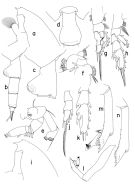 issued from : T. Park in Bull. Scripps Inst. Oceanogr. Univ. California, San Diego, 1995, 29. [p.180, Fig.70]. Female: a, forehead (left side); b, urosome (left); c, genital somite (left); d, idem (dorsal); e, A2; f, Mx1 (first inner lobe omitted), posterior; g, P1 (anterior); h, P2 (anterior). Nota : Laterally as well as dorsally, distal end of each side of prosome sharp-cornered and far from reaching genital prominence. Laterally, genital somite (fig. c) with an inconspicuous dorsal hump anterior to middle ; genital prominence extending almost down to distal end of somite, its anterior margin nearly flat and sloping about 45° with respect to long body axis and distally curved to form smoothly bulging ventral margin of prominence; genital flange low, single-lobed with rounded outline ; posterior margin of genital prominence smoothly arched, meeting ventral wall of somite at a right angle; posterior edge of genital field not visible laterally ; dorsally , genital swelling (fig. d) of more or less angular outline peaking about ¾ length of somite from its proximal end. In P1 exopod, 1st segment with convex outer margin and relatively well developed outer spine; outer spine of 2nd segment reaching close to base of following outer spine. In P2 exopod, outer spine of 2nd segment reaching reaching middle of following outer spine ; 2nd outer spine of 3rd segment reaching base of following outer spine and longer than outer spine of 2nd segment by 1/5 its length ; second marginal lobe of 3rd segment separated from segment by deep incision. Cephalosomal appendages and swimming legs as in P. pseudotonsa except that basis and 1st endopodal segment of A2 each with a single seta and bais of Mx1 with 4 setae, small outermost seta being absent.. Male: i, forehead (left); j, exopod of P1 (anterior); k, exopod of P2 (anterior); l, exopod of left 5th leg (anterior); m, distal exopodal segments of left 5th leg (anterior, tilted counterclockwise); n, serrated lamella of left 5th leg exopod from different specimen (anterior, tilted counterclockwise).
|
 issued from : T. Park in Antarctic Res. Ser. Washington, 1978, 27. [p.232, Fig.84]. As Euchaeta tonsa. Female: A, B, C, distal end of metasome and genital segment (dorsal, left side, and ventral respectively). See remaks on Paraeuchaeta pseudotonsa
|
 issued from : R.B.S. Sewell in The John Murray Expedition, 1933-34, Scientific Reports, VIII (1), 1947. [p.128, Fig.29, C]. As Paraeuchaeta spinifera. With doubt. Male (from central Arabian Sea): : C, anal segment (lateral)
|
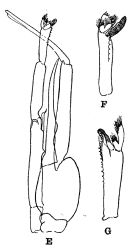 issued from : R.B.S. Sewell in The John Murray Expedition, 1933-34, Scientific Reports, VIII (1), 1947. [p.128, Fig.29, E, F]. As Paraeuchaeta spinifera. With doubt. Male from Arabian Sea): E, P5; F, clasping organ of left P5.
|
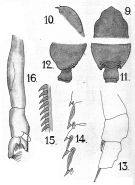 issued from : A. Scott in Siboga-Expedition, 1909, XIX a. [Plate XXII, Figs.9-16]. As Paraeuchaeta spinifera. Male (from Banda Sea): 9, forehead (dorsal); 10, idem (lateral); 11, last thoracic and genital segments (dorsal); 12, idem (left side); 13, P1 (exopodite only); 14, P2 (outer margin of exopodite); 15, part of terminal spine of exopodite of P3; 16, P5 (part of left leg).
|
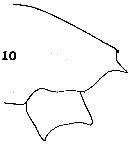 issued from : C.O. Esterly in Univ. Calif. Publs Zool., 1906, 3 (5). [Pl.9, Fig.10]. As Euchaeta tonsa. Female (from San Diego, California): 10, forehead (lateral).
|
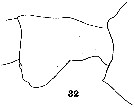 issued from : C.O. Esterly in Univ. Calif. Publs Zool., 1906, 3 (5). [Pl.10, Fig.32]. As Euchaeta tonsa. Female: 32, last thoracic segment and genital segment (lateral).
|
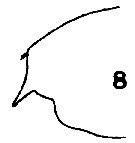 issued from : C.O. Esterly in Univ. Calif. Publs Zool., 1906, 3 (5). [Pl.9, Fig.8]. As Euchaeta spinifera. Male (from San Diego, California): 8, forehead (lateral).
|
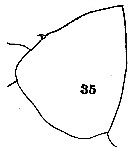 issued from : C.O. Esterly in Univ. Calif. Publs Zool., 1906, 3 (5). [Pl.11, Fig.35 ]. As Euchaeta spinifera. Male, 35, last thoracic segment (lateral).
|
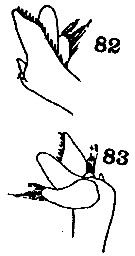 issued from : C.O. Esterly in Univ. Calif. Publs Zool., 1906, 3 (5). [Pl.14, Figs.82- 83]. As Euchaeta spinifera. Male, 82-83, distal portion of 2nd segment of exopod of left P5.
|
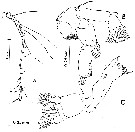 issued from : M. Fontaine in Crustaceana, 1967, 12 (2). [p.199, Fig.4]. As Euchaeta tonsa. Female (from N Pacific): A, A1; B, A2; C, Md. Nota: A1 23-segmented (8th-9th and 24th-25th segments fused). A2 endopod approximately 3/4 as long as exopod. Md palp with endopod 2-segmented; exopod 5-segmented, each of first 4 segments with 1 internal long plumose seta, 5th segment with 2 apical plumose setae; gnathobase edge with 6 strong teeth, decreasing in size, the largest the most ventral.
|
 issued from : M. Fontaine in Crustaceana, 1967, 12 (2). [p.202, Fig.5]. As Euchaeta tonsa. Female: A, Mx1 (B1: 1st basal segment; o.l.1: 1st outer lobe of B1; gna: 1st inner lobe or gnathobase of B1; i.l.2: 2nd inner lobe of B1; i.l.3: 3rd inner lobe of B1; B2: 2nd basal segment; En.1: 1st endopod segment; En.2-3: partially fused 2nd and 3rd endopod segments; Ex: exopod). B, Mx2 (B1: 1st basal segment; 1-4: 1st to 4th inner lobes of B1; B2: 2nd basal segment; 5: inner lobe of B2; En.: endopod). C, Mxp
|
 issued from : M. Fontaine in Crustaceana, 1967, 12 (2). [p.198, Fig.3, D]. As Euchaeta tonsa. Female: D, genital segment (ventral). g.l.: genital lobe; g.a.: genital aperture; r.: ridge posterior to genital aperture. Nota: Genital aperture in middle of posterior surface of genital swelling. Genital lobes (referredto as platesby With (1915), flanges by Tanaka (1958) lateral and anterior to genital apertures, very small; posterior to genital aperture a broad horizontal ridge, expanded to a bulge at each end. Anterior to genital swelling, and ventrally on each side of genital segment a small round protuberance; anterior to protuberance a slight depression in middle of ventral surface.
|
 issued from : M. Fontaine in Crustaceana, 1967, 12 (2). [p.198, Fig.3, A-C]. As Euchaeta tonsa. Female: comparison of genital segments (lateral) from P. tonsa (A), P. pseudotonsa (B) and P. tuberculata (C).
|
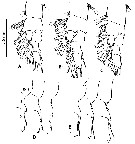 issued from : M. Fontaine in Crustaceana, 1967, 12 (2). [p.203, Fig.6, D]. As Euchaeta tonsa. Comparison of P1 females from P. tonsa (A), P. pseudotonsa (B) and P. tuberculata (C) (as E. scaphula). D, variation in length of external setae on P1 of P. tonsa (Ex.1-3: exopod segments 1-3); E, variation in length of the same setae in P. pseudotonsa.
|
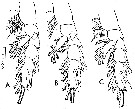 issued from : M. Fontaine in Crustaceana, 1967, 12 (2). [p.204, Fig.7, A-C]. As Euchaeta tonsa. :Comparison of P2 females from P. tonsa (A), P. pseudotonsa (B), and P. tuberculata (C) (as E. scaphula).
|
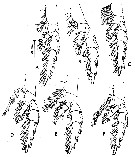 issued from : M. Fontaine in Crustaceana, 1967, 12 (2). [p.205, Fig.A-C, D-F]. As Euchaeta tonsa. Comparison of P3 females (A-C) from P. tonsa (A), P. pseudotonsa (B), and P. tuberculata.
Comparison of P4 females (D-F) from P. tonsa (D), P. pseudotonsa (E), and P. tuberculata (F) (as E. scaphula).
|
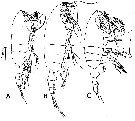 issued from : M. Fontaine in Crustaceana, 1967, 12 (2). [p.196, Fig.1, A-C]. Comparison of habitus (lateral views) females between P. tonsa (A), P. pseudotonsa (B), and P. tuberculata (as Euchaeta scaphula). Nota concerning P. tonsa Female (from San Diego and Monterey Bay): last thoracic segment not prolonged posteriorly, bearing on each side a small teeth, but with no hairs or setae. Appendicular caudal seta geniculate, slender and non plumose, longer than terminal setae 1, 3 and 5, about 2/3 as long as terminal seta 2. Genital segment with its widest part far posterior to middle of segment
|
 issued from : M. Fontaine in Crustaceana, 1967, 12 (2). [p.197, Fig.2, A-C]. Comparison of habitus (dorsal views) females between P. tonsa (A), P. pseudotonsa (B), and P. tuberculata (as Euchaeta scaphula).
|
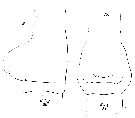 issued from : W. Giesbrecht in Bull. Mus. comp. Zool. Harv., 1895, 25 (12). [Taf. IV, Figs.9-10]. Female (from 35°N, 125°W): 9-10, genital segment (lateral and ventral, respectively).
|
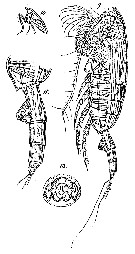 Issued from : G.O. Sars in Résult. Camp. Scient. Prince Albert I, 69, pls.1-127 (1924). [Pl. XXXIII, figs.9-12]. As Pareuchaeta tonsa. With doubt. Female: 9, habitus (lateral); 10, forehead (lateral); 11, last thoracic segment and urosome (left side); 12, genital area (ventral).
|
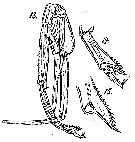 Issued from : G.O. Sars in Résult. Camp. Scient. Prince Albert I, 69, pls.1-127 (1924). [Pl. XXXIII, figs.13-15]. As Pareuchaeta tonsa. With doubt. Male: 13, P5; 14, end of left P5 (enlarged); 15, denticle lamella of the left P5.
|
 issued from : F. Vives & A.A. Shmeleva in Fauna Iberica, 2007, 29. [p.671, Fig.373, D]. Female: c, corner of the last thoracic segment and genital segment (left side). Nota: In lateral view, tip of the corner dentiform-like, located far from the genital swelling. Laterodorsal margin ot the triangular segment nearly straight.
|
 Paraeuchaeta tonsa Paraeuchaeta tonsa Female: 1 - See key to species Groups and independent species of Paraeuchaeta (p.30). 2 - Laterally, genital field facing ventrad, without large tubercular outgrowth behind genital orifice (Fig.70-c). 3 - Genital somite without tubercular outgrowth on dorsal side (Fig.70-c). 4 - Laterally, posterior edge of genital field not visible (Fig.70-c). 5 - Dorsally, genital somite with angular (pear-shaped) lateral sides (Fig.70-d).
| | | | | Compl. Ref.: | | | ? De Decker & Mombeck, 1964 (p.13); Suarez-Morales & Gasca, 1998 a (p.109); ? Valdés & al., 2007 (p.104: tab.1); ? Cabal & al., 2008 (289, Table 1); Morales-Ramirez & Suarez-Morales, 2008 (p.520); Galbraith, 2009 (pers. comm.); Park & Ferrari, 2009 (p.143, fig.1, biogeography); ? Labat & al., 2009 (p.1746, Table 2); ? Medellin-Mora & Navas S., 2010 (p.265, Tab. 2); in CalCOFI regional list (MDO, Nov. 2013; M. Ohman, comm. pers.); El Arraj & al., 2017 (p.272, table 2, spatial distribution); | | | | NZ: | 10 + 4 doubtful | | |
|
Distribution map of Paraeuchaeta tonsa by geographical zones
|
| | | | | | | | |  issued from : T. Park in Hydrobiologia 292/293, 1994. [Fig. 4, p.328].
Geographical distribution of Paraeuchaeta tonsa (triangle) and P. pesudotonsa (circle). issued from : T. Park in Hydrobiologia 292/293, 1994. [Fig. 4, p.328].
Geographical distribution of Paraeuchaeta tonsa (triangle) and P. pesudotonsa (circle). |
| | | | Loc: | | | ? South Africa (E), ? Namibia, ? G. of Mexico, ? Florida, ? Morocco-Mauritania, ? off Canary Is., ? off Madeira, ? Azores, ? Iberian coast, ? Bay of Biscay, ? ibero-morocco Bay, ? Algiers, ? Arabian Sea, Indian (E & SW), Indonesia-Malaysia, ? Japan, ? Kuril Is., ? off S Aleutian Is., Pacif. (central N-S), off British Columbia, California, W Costa Rica, Australia (Great Barrier), Pacif. (SE tropical), off Juan Fernandez Is., Chile | | | | N: | 16 | | | | Lg.: | | | (3) F: 6,7-5,6; M: 5,9-5,3; (5) M: 5,5; (11) M: 6,28; (17) F: 6,1; M: 5,1; (18) F: 6,3-5,95; (47) F: 6,1-6; {F: 5,60-6,70; M: 5,10-6,28}
The mean female size is 6.107 mm (n = 7; SD = 0.3372), and the mean male size is 5.616 mm (n = 5; SD = 0.4746). The size ratio (male : female) is 0.920, or ± 92 %. | | | | Rem.: | After Park (1995, p.72) the species was originally described from off California (35°N, 125°W). In Park's samples, the species was found along the west coast of North America between 38°N and 29°N, in the central Pacific between 31°N and 40°S, in the western Pacific Ocean including the Malay Archipelago between 10°N and 14°S, and in the eastern tropical Indian Ocean between 5°S and 10°S.
After Fontaine (1967, p.201) Davis' (1949) report of E. tonsa from the Washington coast is probably accurate; he believed his specimens to be synonymous with those of Scott (1909) from the East Indian Archipelago, but his figure of the abdomen and last thoracic segment shows the genital swelling to be rather triangular in lateral view, not bulging as in Scott's drawing. He also listed as synonymies the Atlantic specimens of With (1915) and Sars (1925) by error (confusion with P. pseudotonsa).
See remarks on Paraeuchaeta pseudotonsa and the distribution according to Park, 1994.
The Atlantic localisations, and in part those from the Indian Ocean, are not retained (cf. Park, 1995, p.74, 75). However, Vives (1982, p.291) reports jointly this species and P. pseudotonsa in the region of the Canary Islands.
For Vives & Shmeleva (2007, p.672) P. tonsa inhabits in the Gulf of Biscay, the Gulf Ibero-Morocco, Portugal and the W Mediterranea Sea. | | | Last update : 28/10/2022 | |
|
|
 Any use of this site for a publication will be mentioned with the following reference : Any use of this site for a publication will be mentioned with the following reference :
Razouls C., Desreumaux N., Kouwenberg J. and de Bovée F., 2005-2025. - Biodiversity of Marine Planktonic Copepods (morphology, geographical distribution and biological data). Sorbonne University, CNRS. Available at http://copepodes.obs-banyuls.fr/en [Accessed December 29, 2025] © copyright 2005-2025 Sorbonne University, CNRS
|
|
 |
 |

























